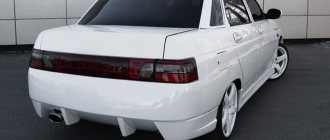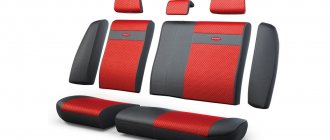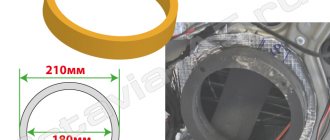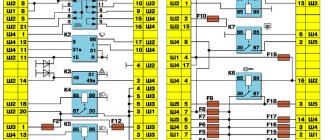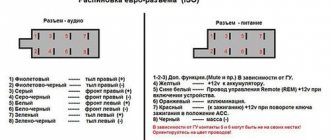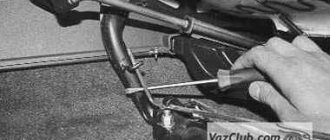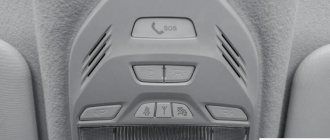Publication date: February 20, 2022. Category: Automotive equipment.
When the vehicle is used intensively, standard seat upholstery not only gets dirty (and it is quite difficult to clean them), but also wears out. Subsequent repairs (the so-called reupholstery of the interior) are expensive, and it’s quite difficult to do it yourself. You can avoid such troubles very simply: just “dress” the chairs in covers. Today, such accessories can either be purchased (they are presented in a large assortment, both universal and designed for a specific car model); or order (they are sewn in specialized studios); or make it yourself, saving a significant amount of money. At the same time, you can be sure of the exclusivity of the manufactured products.
Making car covers with your own hands is one of the most critical stages of the manufacturing process. Not only the ease of using homemade covers in the future (install, remove, wash and install again), but also the aesthetic appearance of the car interior depends on how accurately the blanks are made.
Sequencing
So, if you decide to make car seat covers yourself, then you need to decide on the procedure.
The first thing you should start with is to determine (by experiment) what thickness and density of the material can be sewn using the sewing machine you have. The choice of material for making covers will largely depend on this. Attempts to sew through too dense material can lead to its breakage and unjustifiably expensive repairs.
Then you need to make all the necessary patterns. The number of individual elements will depend on the configuration of the chair and armrests.
And only after that we decide on the amount of material needed.
Tools and materials
Before you get started, you need to prepare the following tools:
- Tailor's scissors;
- Fabric glue;
- Sewing machine;
- Centimeter or ruler;
- Fabric and materials;
- Hairdryer and iron;
- Tools for removing seats and old accessories;
- Awl for making leather.
Important! Depending on the type of cover and vehicle, the list of tools, equipment and materials will vary, but only slightly. In general, this should be enough to make a cover for a car.
It is worth remembering that all parameters must be measured individually
Selecting material for car covers
To make your own seat covers, you can use a variety of synthetic or natural materials:
- velours;
- tapestry;
- cotton;
- neoprene;
- plush;
- leather (natural or artificial);
- various synthetic fabrics and so on.
Each of the materials has both its advantages and disadvantages. For example, the undoubted advantages of natural materials include: their environmental friendliness and “breathable” properties. Although they are less durable than synthetic materials. And leather, although it has numerous advantages (both in durability and aesthetic characteristics), is quite difficult to process. In addition, the price for such material is very high.
A combination of different materials is quite acceptable: for example, velor can be used for the main elements, and synthetic leather can be used for the armrests.
Both the comfort of the driver and passengers, as well as the convenience of subsequent operation, largely depend on the correct choice of fabric. Everyone makes the final decision, taking into account their financial capabilities and individual preferences. The main thing is that the selected material provides sufficient protection for the standard upholstery, so as not to carry out subsequent repairs.
How to choose material
Step number 2 - choosing the right material. Fortunately, the fabric market for these purposes has a huge number of variations. Each material has its own unique properties, advantages and disadvantages. You should choose not only based on your personal preferences and price, but also based on the overall color scheme of the car. The most popular fabrics can rightfully be considered:
- Natural or artificial leather. The most used option, because it looks expensive and stylish, but in fact it can cost little. If you properly care for such a cover, it will look perfect for years and protect the seats from external factors. The disadvantage is obvious: genuine leather is expensive, but even it does not provide warmth in cold weather;
You might be interested in Interesting pants patterns: step-by-step construction instructions
Leather or substitute capes add solidity
- Natural or faux fur. These accessories do not have the disadvantages of the first type, since they retain heat perfectly. Among natural options, preference should be given to sheep and goat wool. Faux fur does not retain heat as well and often serves only a decorative function;
The covers can be made from fur, they will keep the driver warm
- Velours. A simple and economical option. Its main advantage is that it maintains a neutral temperature in any weather. Proper care will be simple and will preserve the good quality of the fabric for many years;
Velor covers have a pleasant texture
- Neoprene. Practical synthetic material. It looks very modest and practically does not stand out in any way, either from the pros or the cons. Caring for it will help it remain the same as on the first day of purchase;
Neoprene is practical and comfortable in the summer
- Polycotton. Semi-synthetic material that combines the main advantages of polyester and cotton. Thanks to its moisture-repellent properties, it can easily withstand machine washing in any mode;
Polycotton is an excellent material for capes
- Vinyl. Synthetics in their purest form, which has proven itself for its practicality and high performance characteristics. Cleaning does not require special means or modes;
Vinyl car covers
- Suede and its substitutes. Such cases are quite expensive and are not found often. They need to be well looked after, otherwise they will quickly lose their presentable appearance and properties.
Suede covers require careful care
Making a pattern using special tape and paper
The seats of modern cars have a rather complex shape. This is explained by the fact that manufacturers try to give them the most ergonomic shape.
In order for homemade covers to not look like a “potato sack”, it is necessary to most accurately repeat the geometric shape of the vehicle seats in the pattern. It's difficult, but possible.
To create a pattern for car seat covers with your own hands, we will need:
- double-sided paper adhesive tape (very similar to regular masking tape);
- scissors;
- soft paper (it is better to use special paper for patterns, which is sold in rolls in specialized stores);
- marker.
Let's start with the driver's seat. Work execution algorithm:
- We lay out a sheet of paper on the seat, smooth it with our hands and adjust it (in size) to the main part of the driver’s seat.
- We secure this part with pieces of paper adhesive tape so that it does not reach the seams of the standard sheathing by 1-2 mm.
- We perform the same procedures with the remaining parts of the seat (side and front end).
- After all the elements of the lower part of the seat are covered with blanks, we apply the necessary marks with a marker (so that later we do not get confused in the resulting patterns).
Pattern and sewing of a sun awning
To sew a cover to protect the car body, you also need to make a pattern. As a rule, the cover consists of several parts: side and central, running along the roof, trunk and hood. To take measurements, you should take into account the length of the body and its geometry. You can resort to a simple method for taking measurements: take a long cord and stretch it from the bottom edge of one bumper to the other. Then measure its length, making a small supply of material (20–30 cm). Side elements are measured at three points: roof, trunk and hood. After the measurements, the margin is added, the resulting result is divided in half, and the approximate contour of the car is marked on the material using three values. In the above version, the awning will be made of three parts.
Another option is also possible, which also involves the use of three separate parts, only located across, and not along. In this case, use a cord to measure the length of the hood, roof and trunk, not forgetting to note the width of each element, and sew the finished patterns together. In places where mirrors are located, make a small margin, which depends on their size (up to 50 cm). The final step when sewing the awning is to stretch the elastic or cord along the contour, which will allow you to fix the cape to the body. To do this, make a hem and stitch, then thread the cord.
Fines for crossing the stop line and speeding will no longer bother you!
When sewing an awning yourself, it is important not only to choose the fabric, but also to pay attention to the seams: the fabric must be folded twice to avoid damage to the paintwork of the body
To sew an awning yourself, the main thing is to purchase a special fabric and, when sewing the elements, pay attention to the seams: they are made with a double hem, which will prevent damage to the paintwork due to the rigidity of the seams. In addition, such seams will hold their shape better. Quite strong threads are used for sewing, and reinforced ones made of polyester are considered the best for these purposes, since they are able to withstand environmental influences.
To sew seat covers that exactly match the model of your car, you need to make patterns in any of the possible ways. After that, all you have to do is be patient and put in some effort. Only in this case will you be able to get exactly the product that will fit perfectly and harmonize with the interior of your car.
Car covers have a nasty tendency to wear out and get dirty, so they need to be changed over time. But since car repair services are not cheap, you can always find a way out - this could be sewing car covers at home, for example.
Polyethylene patterns
Instead of pattern paper, you can use regular greenhouse film. For this you will need:
- medium density polyethylene;
- scissors;
- marker;
- pins.
- we cut out a blank from polyethylene that is slightly larger in size than the seat element;
- lay it out on the seat;
- carefully attach it with pins;
- using a marker, apply markings (along the stitching lines of the standard seat trim);
- remove the pins and remove the polyethylene;
- cut out the blanks according to the applied markings using scissors;
- We do the same with all elements of the chair (sidewalls, protrusions, bends);
- carefully secure all the workpieces with pins to the corresponding elements of the seat;
- using a marker we apply all the necessary notes and inscriptions;
- lay out the polyethylene elements on hard cardboard and trace them with a marker;
- Using the applied markings, we cut them out with scissors and get patterns for car covers with our own hands.
We make patterns for the rear seats and armrests in the same way.
Tips and tricks
A few tips for even better quality work and increasing the practicality of products:
- To make putting on and taking off the covers easier and easier, you should add zippers in the areas that will be on the armrests;
- If the seats can lean back along certain elements, then the usual type of covers will not fit under them;
- Some models have airbags located in the backrests. If the covers are without special slots, the pillows will not open.
New Lada: Maximum benefit on Largus station wagon
Leather covers for Suzuki Grand Vitara
Thus, the question of how to sew a cover on a car seat with your own hands was discussed, and examples of patterns for making car covers with your own hands were also given. Sewing car covers is not difficult. At the level of furniture restoration, installing and sewing car covers allows you to keep the seats in order or restore their already damaged appearance.
Cover-cape
The dirtiest and most worn parts of car seats are the base (where you sit) and the inside of the backrest. It’s quite easy to protect them by making cape covers yourself. Moreover, you can periodically replace them without a significant blow to your budget, since they have a relatively low cost.
To make them you will need:
- any natural fabric, such as a large terry towel;
- scissors;
- threads;
- needle;
- pins;
- sewing machine;
- marker or chalk.
It is not necessary to make patterns for such cases. Everything is very simple:
- remove the headrest;
- carefully lay out the fabric on the seat and back with an overlap of 10-15 cm;
- we make holes in the material (for subsequent installation of head restraints);
- install the headrests in place (to fix the upper part of the fabric);
- Once again we level (with tension) along the entire seat;
- we fold the excess fabric inward and secure it with pins or baste with a needle and thread;
- we outline places for attaching laces or elastic bands (to secure the covers on the chair);
- remove the fabric and sew capes on a machine according to the basting;
- We attach the cover-cape to the seat using sewn ropes or elastic bands.
On a note! Knitted covers on car seats look very original. If we knit them from durable natural yarn of various colors, we get products that meet the requirements both for durability and exclusivity, health safety and ease of use. In addition, knitting a cover, for example, for an armrest, is much easier than sewing it.
Making a chair cover with your own hands
Sewing a seat cover yourself is not too difficult. The whole process can be divided into several stages:
- selection of cover type and material;
- taking seat measurements;
- pattern making;
- sewing a cover.
Selecting the type of case
First of all, decide what kind of case you need. All of them can be divided into several categories:
- T-shirt capes;
- model cases;
- knitted covers;
- massagers;
- heated covers.
The T-shirt cover is one of the most versatile and popular types of covers among motorists. It got its name because of its specific style, which really resembles an ordinary undershirt. They are convenient and practical: they are easy to remove and clean from dirt. In winter, sitting on them is much warmer and more comfortable than sitting on cold leather upholstery. In addition, with proper selection of colors, such covers will look very stylish in the interior of the car. Choose a shade similar to the seats to make the covers as discreet as possible, or create a special accent with a contrasting color.
a T-shirt-shaped cover is considered classic
Model covers are made individually for each seat. They fit tightly and exactly follow the shape of the chairs. They are quite difficult to take off and put on for washing. You can order such covers only in special stores or car workshops.
model cases not only look, but are also quite expensive
Knitted capes resemble T-shirts in their properties, but are made not from ordinary fabric, but from yarn. If you have experience in crocheting, try making a cozy and original cover for yourself.
crocheted capes will create coziness in the car
Massager capes are distinguished not only by their original appearance, but also by their benefits for the body. It's no secret that a person's back experiences a lot of physical stress and can get very tired after a hard day at work. But with the modern rhythm of life, not everyone has free time to visit a doctor. This is where massagers come to the rescue. They can be divided into two types: passive and active.
Passive massagers were very often found on car seats in Soviet times. They consist of wooden balls or cylinders strung on a frame, which precisely apply pressure to your back and neck as you move.
The passive cover will massage your back and neck with every body movement
But now active massagers are gaining more and more popularity. Outwardly, they look like regular T-shirts, but inside they have a special roller or vibration mechanism. It comes into action when you connect the cape to the cigarette lighter. With such a case, time spent in traffic jams and at traffic lights will fly by unnoticed.
active massager covers are equipped with a special vibration or roller mechanism
Covers made from wooden elements cool quickly at low temperatures. Therefore, using them in winter will not be very comfortable.
And, of course, you can’t ignore the heated covers. Outwardly, they are similar to T-shirt capes, but at the same time they have a heating element that makes the seat warm even in the coldest weather.
heated covers are especially useful in cold weather
Secrets of choosing material
The second step is choosing the material for the future product. Today, the car accessories market offers a wide range of fabrics and materials for sewing covers. Each of them has its own unique properties, advantages and disadvantages. Choose the material based on your taste preferences and how you use your car. Among the most popular materials are the following:
- natural and artificial leather (eco leather);
- natural and artificial fur;
- neoprene;
- velours;
- polycotton;
- suede leather;
- vinyl.
Genuine leather is one of the most popular materials for cases. It looks expensive and stylish, while being quite easy to care for. With proper care, a leather cape will serve you for many years, and protection from ultraviolet rays will prevent it from fading in the sun. However, this material has a couple of significant drawbacks: for example, leather does not retain heat well, which will create inconvenience in cold weather. In addition, with sudden temperature changes, unsightly cracks may form on it. Eco-leather is a smart choice for those who want to get all the benefits of natural material, but are not ready to pay the full price.
genuine leather covers will give your car a solid look
No less popular are capes made of natural fur. Their main advantage is the ability to retain heat in cold weather, which, unfortunately, leather covers are not capable of. Sheep and goat wool are considered the highest quality materials: they do not fade and retain their original appearance for a long time. But faux fur cannot boast of the same. In addition, it is not as good as insulation as its natural counterpart. As a rule, faux fur covers serve only a decorative function.
fur covers will keep you warm in cold weather
The color range of both artificial and natural fur covers can be very diverse. Upon special order, the material will be painted in any color of the rainbow.
Perhaps the main disadvantage of such a cape is that it quickly becomes dirty. At the same time, you can clean it yourself only from dust and small crumbs. And even then you will need a car vacuum cleaner for this. But only dry cleaning will help get rid of large stains with bright colors and a strong odor.
Neoprene is a practical synthetic material that looks modest, but does not have any particular disadvantages. Neoprene is resistant to temperature changes and is not flammable. With regular cleaning, it will hardly wear out and change its properties. Neoprene is suitable for those who prefer practicality to beauty.
Neoprene capes are practical and easy to use, especially in the summer
Making covers from velor is one of the most economical options due to the low cost of materials. It maintains a neutral temperature in any weather. It is quite easy to care for: timely washing and ironing will help it remain soft to the touch for a long time.
velor covers have a pleasant texture
Polycotton, as you might guess from the name, combines the advantages of natural cotton and synthetic polyester. Due to its water-repellent properties, it can easily survive machine washing, so it is suitable for those who often carry small children and animals.
Suede covers are not so common among motorists, so they are suitable for those who love everything unusual. They look expensive and elegant, and with proper care they delight owners with their durability. The main thing is not to forget to clean the suede from dirt in a timely manner.
Suede covers require careful care
And finally, vinyl. This is a synthetic polymer material that is highly practical: it does not allow or absorb moisture, is difficult to get dirty and is easy to clean from dust and small stains.
vinyl covers do not allow moisture to pass through and are easy to clean from dirt
Taking measurements for the future car cover
Just like when sewing regular clothes, before making a car seat cover, you need to take measurements from the seats. To do this you will need the following parameters:
- height and width of seat backs;
- length and width of the bottom pillow;
accurately measure all the necessary parameters of the seats to make the pattern
Note! The figures shown in the image are not universal for all car seats. Measure all the necessary parameters for making the pattern yourself.
Remember that when making a pattern you need to add a margin of 2-3 cm in each direction; it will come in handy when sewing the parts together.
For ease of work, you can take a regular oilcloth, which is slightly larger than the dimensions of the seat. Then use a marker to transfer the outline of the chair onto it, paying attention to the seams. After this, you need to cut out the resulting diagram along the contours and cut it into its component parts. This blank will help you accurately transfer the pattern onto the fabric.
for convenience, transfer the contours of the chairs onto transparent film
Nuances of patterns for car seats
In order to make a pattern, and subsequently sew a high-quality cape for a car using it, you need to prepare the following set of tools:
- markers;
- meter tape;
- chalk for cutting;
- sharp tailor's scissors;
- stationery knife with a wide, dense blade;
- a set of threads of suitable colors;
- needles and pins;
- sewing machine.
the pattern pieces are sewn together according to this pattern
- In order to make a pattern for covers, you need to do the following:
- Take the prepared polyethylene parts and use chalk to carefully transfer their outlines onto the fabric. Remember to spare centimeters on each side.
- Place the pieces on the fabric in such a way as to use its entire surface and leave as few empty areas as possible. In this case, the distances must be calculated so as not to accidentally touch the adjacent part with scissors. Even if you have never sewed before, remember your school crafts lessons and crafts made from colored paper.
- Before cutting out the pieces, cut the fabric into several small pieces. This will make your work more convenient.
- Carefully cut out the pattern, helping in some places with a utility knife.
- If the fabric is very wrinkled during the previous steps, you can lightly iron or steam it. This will make the stitching process easier.
Patterns of seat covers for Volga car in the photo
pattern diagram for the front seat of a Volga car
pattern diagram for the rear seat of a Volga car
pattern diagram for the rear seat cushion of a Volga car
Table: Important explanations for machine parts
| Item no. | Detail | Number of parts per case |
| I. Front seat cover (Fig. 1) | ||
| Front seat cushion cover assembly (1) | ||
| 2 | Front end | 1 |
| 3 and 4 | Side part | 2 (left and right) |
| 5 | Top part | 1 |
| 6 | Holder | 5 |
| Front seat back cover (7) | ||
| 8 | Rear end | 1 |
| 9 | Top part | 1 |
| 10 | Front end | 1 |
| 11 and 12 | Side part | 2 (left and right) |
| II. Rear seat cushion cover (Fig. 2) | ||
| 13 | Front end | 1 |
| 14 and 15 | Side extension | 2 (right and left) |
| 16 and 17 | Side part | 2 (right and left) |
| 18 | Top part | 1 |
| 19 | Holder | 12 |
| III. Rear seat back cover (Fig. 3) | ||
| 20 | Front end | 1 |
| 21 | Top part | 1 |
| 22 | Rear end | 1 |
| 23 and 24 | Side part | 2 (right and left) |
| 25 | Holder | 14 |
Of course, the size and shape of the parts will vary depending on the make and model of the car. Refer to the images here to correctly cut the material for your car seats.
That's it, your pattern is ready. All that remains is to assemble the parts together.
Sewing a cover: step-by-step guide
After you have cut out all the components of your capes from the fabric, you need to carefully sew them together. It was for these purposes that spare centimeters were left at the edges of the parts. First, connect the pieces of fabric using pins, and then finish them with a hand basting stitch. If you make a mistake at any stage, such a seam will be easy to rip.
Once you are sure that you have done everything correctly, start sewing the elements together using a machine.
If you have chosen soft fabric for the cover, but want to increase its density and strength, use the following trick: make similar patterns on the mattress fabric, and then sew each piece with the wrong side inward. For even greater compaction, fill the covers with foam rubber.
To keep the chair in place, take care of the fixing elements: hooks, elastic bands and garters.
Don't forget about the design features of your seats, such as seat belts and an armrest in the back row. In addition, the covers must not interfere with the deployment of the airbags. Take care in advance to create the necessary slots in these places.
To make the seams stronger and more durable, add durable leather or nylon tape to them.
Video: how to sew a car cover with your own hands
Car trunk covers
If you often have to transport building materials, tools, sports equipment (skis or skates) or pets (with sharp claws) in the trunk of a car, then the standard upholstery (this is usually carpet) quickly becomes unusable. Subsequent repairs cost a pretty penny. To protect the bottom, side walls and backs of the rear seats (in hatchbacks, station wagons and SUVs) from dirt and scratches, you need to install a protective cover in the trunk. Such a functional device can now be purchased at any car accessories store. But the most rational and economical way is to make it yourself. Moreover, this is much easier to do than seat covers. The main requirement for this element is practicality (durability, ease of installation/removal and cleaning).
The work order is as follows:
- using a tape measure, carefully take measurements of the luggage compartment;
- We make a sketch based on the measurements taken;
- we purchase the required amount of durable, moisture-resistant and easy-to-clean material (for example, tarpaulin, durable “raincoat” or thick dermantine);
- in accordance with the sketch, we apply markings to the material and cut out blanks;
- sew individual elements together;
- we install the cover in the car and mark places for fastening devices (hooks or ropes (in accordance with the technological holes available in the trunk);
- We fix the fasteners on the finished product.
Features of sewing covers
When sewing covers yourself, you should take into account the features of the seats. Some cars have airbags on the front side. If you put covers on top of such seats, the cushions will not expand. In order not to disrupt the functionality of the system, the upholstery is simply cleaned. If you still decide to make covers, then leave cuts in the places where the pillows fly out, stitching them with cotton thread, which will not interfere with the element flying out. In areas with an armrest, zippers can be sewn in, which will make it easier to remove and put on the covers. There are cars in which the seat backs tilt individually. In this case, regular covers will not work.
Wheel covers
Car owners have to change tires twice a year (winter to summer and vice versa). For ease of storage and transportation, special wheel covers are provided. You can either buy such products (fortunately, there are both universal devices and ones for a specific size on sale), or you can sew covers for car wheels with your own hands.
- measure the diameter of the wheel;
- to the resulting value add 1-1.5 cm (per seam) plus 1.5-2 cm (so that the wheel can be inserted into the case without effort);
- draw a circle on the material;
- cut out a round blank;
- measure the circumference and width of the wheel;
- we cut out the following blank from the material, namely, a strip with the following dimensions: width - 2-2.5 more than the width of the wheel; length equal to the circumference of the wheel plus 5 cm;
- then the round blank and the strip are sewn together;
- we bend the free edge of the strip and stitch it so that a “tunnel” is formed into which the cord will subsequently be threaded;
- Place the wheel inside the product and tighten the cord.
For ease of transportation, you can sew a handle made of durable synthetic tape of a suitable width on the outside of the case.
Protective cover-awning for a car - choosing materials and sewing + video
In this article we will look at how to make a protective cover for a car with your own hands, and whether this attribute is really necessary for your vehicle. After all, if you really love your “iron horse,” then you probably want it to always look its best. Then let's get to the fun part.
Prolonged exposure to direct sunlight can have a detrimental effect on the paintwork; in addition, the awning cover will serve as reliable protection from dust, dirt, moisture, as well as the harmful behavior of birds.
And if you don’t have the opportunity to hide your car in the garage, or you just went on vacation and the car is forced to sit in the open sun for several weeks, then a car awning, even hastily made with your own hands, will serve as a real lifesaver.
Basically, such covers are made from special fabrics that do not allow dust and dirt to pass through, but due to their excellent breathability, they can provide excellent air circulation, so moisture has no chance of accumulating under such a car cover. Some of the most popular awning fabrics are Oxford and Tarpaulin, they can provide excellent protection and will last for quite a long period.
These materials have either a polyvinyl chloride or polyurethane coating, which is applied to the reverse side.
The main advantages are lightness, excellent tensile strength, excellent operating temperature range, ease of maintenance, moisture resistance, excellent resistance to abrasion and contamination and fairly low susceptibility to ultraviolet radiation.
Car cover - how to sew?
Typically, such a cover consists of three parts: two side and one central, which runs along the roof, hood and trunk.
When taking measurements, be guided not by the geometric data of the car’s base and body length, which are indicated in the car’s passport, but rather take a soft meter or a simple long cord and run it along the contour of the car from the bottom edge of the front bumper to the bottom edge of the rear bumper. Then measure its length with a tape measure and make a small margin, about 20-30 cm. The side cuts are also measured along the contour of the car, but in three places: along the hood, trunk and cabin roof. The margin is added, the resulting value is divided by two, and an approximate outline is drawn on the fabric based on three indicators. In this case, the protective cape for the car will be sewn from three longitudinal components.
You can do the sewing a little differently. Also use three parts, only not longitudinal, but transverse. Then you need to measure the length of the flap along the hood, along the cab, along the trunk using the same lace method, and do not forget to record the width of each such flap.
The resulting patterns are also sewn together. The margin in the place where the mirrors are located needs to be made a little larger, up to 50 cm, depending on the size of these devices. But if you agree to keep the car with the mirrors pressed down, then you don’t have to do this.
You can complete the awning by pulling a lace or elastic along the contour so that the cape does not lie on the ground, for which you can make a hem and stitch it well; we even have a supply of fabric for this.
Before taking this final step, throw the resulting canvas over the car to eliminate imperfections in the silhouette in any places.
There are several types of protective awnings. The most popular are universal reusable kits. This car cover is sewn from a special fabric that has all the qualities listed above.
The next type is liquid awnings. This is a special substance that is applied to the surface with a brush; its feature is the ability to protect the surface of the car not only when parked, but also while driving.
Introduction
Like any other thing, car covers deteriorate over time. Their service life is affected, of course, not only by their quality, but also by the intensity of use. Not only light models of covers, but also dark ones, require regular washing. But what to do if you urgently need to clean your existing factory “clothes”, but you don’t want to travel without them? Of course, there is no need to run to the auto store for another set, especially since this will require certain costs. You can find a simple and budget-friendly way out of this situation - make car covers with your own hands. Despite the apparent complexity of the process, with certain skills, you can sew a seat cover in just a couple of hours.
Why do you need a car awning?
Few people think about how useful a car awning is. If you do not have your own garage, or it is located far away, such a protective cover will protect your car from many harmful influences. Imagine that you and your family went out into the countryside, but suddenly it began to hail: large ice peas can seriously damage the car’s surface, and sometimes even break the windows. To prevent this from happening, cover the car with an awning.
The cover will reliably protect the car from moisture and dust
Thus, the case performs many useful functions:
- protects the car's paintwork from fading in the sun;
- protects against rain, hail and snow;
- prevents dust from entering the mechanism;
- reliably protects the car from birds and street animals.
As you can see for yourself, this is an extremely useful accessory that can be easily carried with you in the trunk of your car and used at the right time.
There are two main types of awning fabric:
Oxford is a synthetic fabric impregnated with polyvinyl chloride or polyurethane. Its density can reach 500 g/m2.
Oxford has high strength and density
Tarpaulin is a material consisting of durable polyethylene threads that are tightly woven together. It is laminated on both sides with a special light-stabilized film.
Tarpaulin will protect well from moisture and dirt
It is quite easy to care for such materials: clean them as they become dirty with a brush, and periodically wash them in a regular automatic machine. The average price for fabric for awnings varies between 70–180 rubles per m2.
The first stage is choosing the “right” fabric
Fabric for car seat covers should be selected with particular care. The fact is that the comfort of passengers and driver largely depends on the material. If we consider the fabrics that are used by salons for sewing “clothes” for custom-made chairs, it will become clear that they most often offer consumers products made from synthetics. This product is very practical: it is durable, gets dirty a little, and is easy to clean. The car owner can order an “outfit” for seats made of velor, polycotton or neoprene (such covers are characterized by high fire resistance).
However, despite all the positive properties of synthetic fabrics, they have one significant drawback: the flammable material slips and is unpleasant to the touch. Synthetic covers are best used in autumn or winter. In view of this circumstance, seat covers that will be used in the summer are best made from natural fabrics that are breathable and do not irritate the skin. Genuine leather will also be a good material option for covers for this period, however, if it is dermantine, then the driver will sweat a lot.
Selecting a cover type
First you need to decide what kind of product you need and what it will be like. Car covers can be roughly divided into several types. They will be discussed in more detail below. Among them:
- Tank top;
- Model-style case;
- Knitted accessory;
- Case-massager;
- Heated cover.
Tank top
This is the most popular and universal type of car covers. It is called that because its style is similar to a kind of sleeveless men's undershirt. It often leaves the corners, sides and top of the seat exposed to dirt, but protects the main areas: the back and the seat itself. It is precisely because it is easy to take off, put on and wash. It is convenient to sit on such a cover at any time of the year: in winter it is not as cold as skin, and in summer it is not so heated by the sun. If you choose the right color and design, you can stylishly decorate the interior of your car or, on the contrary, hide covers of almost identical interior color.
You might be interested in this All about industrial sewing machines in production
Classic T-shirt style cover
Model-type cases
Such products are made specifically for each car in a special studio or store. They fit perfectly on the surface of the chair and follow its shape. They are quite expensive and difficult to remove. Despite all this, their appearance is striking.
Expensive and stylish fashion capes
Knitted accessory
Outwardly, it resembles a T-shirt cover, but it is made not of fabric, but of yarn. To create one yourself, you need a lot of crocheting experience, many meters of yarn and a lot of patience. All this will pay off in full, because only a knitted warm cover will give the car interior incomparable home comfort and tranquility.
Knitted capes create home comfort
Massager case
This species brings not only spiritual benefits to the body, but also physical ones. The original appearance and function of massaging the buttocks and back are the main functions of such a product. The back of any person experiences heavy loads during the day, and if he spends a lot of time driving, it also becomes twisted and stiff. Not everyone has the time and opportunity to go to a doctor and massage therapist. This is where massage capes come into play, which are divided into active and passive.
The passive cover will massage your back and neck with every movement
Passive ones can often be found in old cars such as VAZ 2109, 2110 and others. They are capes made of balls that spin and massage the back of the driver and his passengers. Modern technologies have gone much further and people began to use active and soft massagers on a remote control. They are simple convex T-shirts with a built-in vibration and massage mechanism.
Important! In such cases you can set your own operating mode and intensity. You can connect the product to a regular cigarette lighter or to a special connector.
Active massager covers are equipped with a special vibration or roller mechanism
Heated covers
You can't ignore heated covers. They look exactly the same as capes or active massagers, but they have a well-known useful function. Such car covers can provide a comfortable ride even in the coldest weather. They are often combined with massage devices and then maximum comfort is created.
Heated capes will delight you in winter
The second stage is taking measurements from the chairs
After the “right” material has been selected, it is necessary to make patterns. Sewing perfectly fitting car covers requires taking measurements. After all, even a cover made of eco-leather or other fabric sewn by the skillful hands of an experienced seamstress will bulge unsightly if it is not sewn to size.
To make patterns, you need:
- take cellophane or a piece of transparent polyethylene in advance, the size of which will correspond to the dimensions of the chair;
- place the prepared polyethylene on the seat in such a way that you can trace each element separately along the seams using a dark marker;
- check the correspondence of the pattern with the actual size of the chair by attaching the cut out parts of polyethylene;
- transfer the resulting patterns onto cardboard (it is more convenient to work with denser patterns);
- transfer the blanks to the material (the details should be outlined with an additional 2–5 centimeter seam allowance).
Preparing for surgery
Before you start sewing covers or cutting them out, you need to prepare the following tools:
- sewing machine;
- a set of sewing needles and pins;
- cutting chalk or marker;
- tailor's meter;
- tailor's scissors and a construction knife.
Pattern for universal cases
Measurements are taken from the car seats in advance. In order to transfer all the patterns onto paper, you can use newspapers or album sheets glued on one side with tape. Some beginners use large-area oilcloth, however, it is not very convenient to work with.
When transferring dimensions to a pattern, you need to remember to add 1-2 cm to the seams on all sides.
Cutting diagram for home car covers
If a car owner does not want or cannot purchase an original set of “clothes” for his seats, he can learn from the material below how to sew car covers with his own hands without spending much money. If you purchase the material you like in advance and prepare patterns, then, after cutting out the parts, you will only need to stitch the individual elements together and equip the product with fastening components (the easiest way is to make ties).
Patterning covers is not a very complicated process, however, when making them, it is worth remembering that an overlap made half a centimeter larger than the size of the seats allows you to sew loose covers that fit better than “clothes” sewn strictly according to the dimensions of the chair.
For a car seat
Special craftswomen have learned how to crochet amazing car covers.
This kind of work will require time, perseverance and imagination, but the result is worth it. For knitting you will need the same film pattern.
Can be knitted as a whole fabric or in separate fragments.
Tie the entire seat or just the necessary part.
Creating simple cases that require no skills
If there is a need to equip your car with original handmade covers that would not require large labor costs and financial investments, you can make such a simple “robe”, to create a pattern for which you only need to measure the volume of the headrests.
The easiest way is to create a car cover with your own hands that would look like a cape. This product can protect chairs from moisture, sand and dirt. Even if the necessary material is not available, you can use an unnecessary thick terry towel or sheet that would be equal in width to the seats. An oilcloth tablecloth, which will act as a water-repellent layer, will not be superfluous.
Sewing car covers for a car will require a relatively long piece of material. First of all, you will need to step back 25 cm from the edge of the fabric to leave some to hang from the chair. At approximately the same level, it will be necessary to mark the center of the future cover, having additionally learned about the required width of the product.
The volume of the headrest must be divided by half so that the horizontal line located in the center corresponds to the found value. The next step is to cut the holes according to the drawn lines.
After a pattern is made from the material, it is necessary to adapt an oilcloth tablecloth from which an identical blank should be made, which would have additional centimeters for indentation on the sides.
To understand how to make such a homemade blank for car seats, you need to place the tablecloth face down, and the terry cloth, respectively, face up. The indents on the bottom layer should be folded inward and the edges pinned together with needles. After this you can start sewing the parts together.
After everything is ready, you need to run a stitch along the edge of the slot to carefully process it.
Important points
The front seats of many car models are equipped with airbags, which are located at the end of the backrests. If you put covers on the seats, this can prevent the pillow from opening at the right time. You can’t put your safety on the line, so these seats need to be cleaned periodically, but under no circumstances should you put on protective covers.
On a note! You can make special cuts in such cases. They are performed at the airbag opening site. When stitching, you need to use a regular thin thread, which can easily break in an accident.
Having carefully studied the material on upholstering car seats, even without experience, the driver can easily sew covers for cars on his own. Ultimately, the car's interior will acquire the beauty that you can enjoy forever. Neither a nail nor a rod, dear motorists!
Video – Sewing eco-leather covers for Lexus LX570
Car seats are an integral part of any car. Many car enthusiasts, in order to prevent chafing and wear of the factory fabric covering, purchase special car covers in the store, or have them sewn to order in special studios. You can also sew car covers with your own hands, having car seat patterns, your chosen fabric, a sewing machine and a little skill and patience. Below is a photo of an example of sewing car covers quickly and easily with your own hands.
